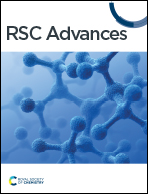Alkylimidazolium-based ionic liquids with tailored anions and cations for CO2 capture†
Abstract
A systematic investigation was conducted in the present study to determine how various cations and anions affected the solubility of CO2. To investigate the influence of different cations and anions on the solubility of CO2, twelve ILs were synthesized, characterized, and utilized. These ILs comprised five distinct anions (dioctylsulfosuccinate [DOSS], triflouromethanesulfonate [TFMS], dodecylsulfate [DDS], 3-sulfobezoate [SBA], and benzene sulfonate [BS]), and four distinct cations (1-butyl-3-propanenitrile imidazolium [C2CN Bim], 1-hexyl-3-propanenitrile imidazolium [C2CN Him], 1-octyl-3-propanenitrile imidazolium [C2CN Oim], and 1-decyl-3-propanenitrile imidazolium [C2CN Dim]). The synthesized ILs were characterized using NMR and elemental analysis. Their moisture and halide contents were determined. The gravimetric method (MSB) was employed to determine the solubility of CO2 at various pressures (20, 15, 10, 5, and 1 bar). In addition, the effects of temperature on the solubility of CO2 were investigated. The constant of Henry's law (kH) was also calculated, along with thermodynamic properties including standard enthalpy (H0), entropy (S0), and Gibbs free energy (G0).



 Please wait while we load your content...
Please wait while we load your content...